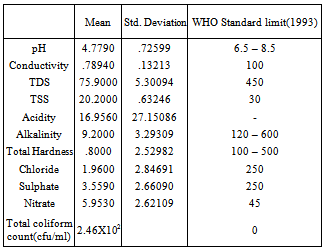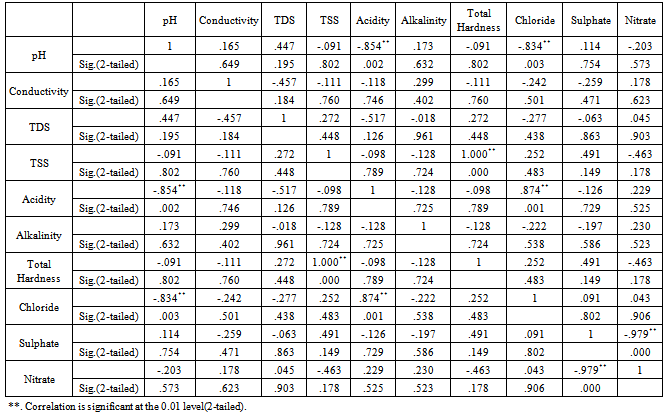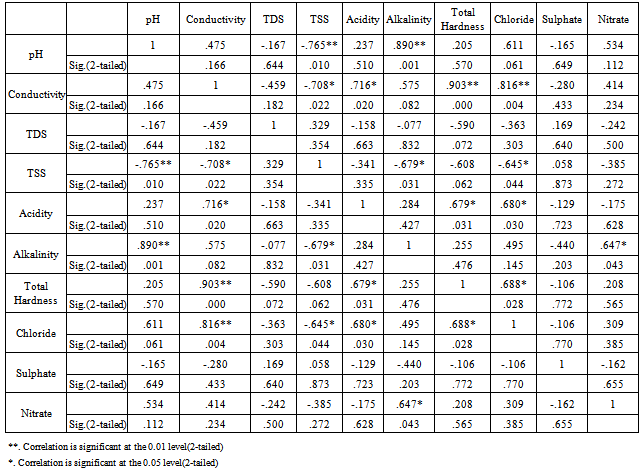-
Paper Information
- Next Paper
- Previous Paper
- Paper Submission
-
Journal Information
- About This Journal
- Editorial Board
- Current Issue
- Archive
- Author Guidelines
- Contact Us
Resources and Environment
p-ISSN: 2163-2618 e-ISSN: 2163-2634
2013; 3(4): 72-76
doi:10.5923/j.re.20130304.02
The Assessment of Drinking Water Sources in Aba Metropolis, Abia State, Nigeria
Agwu A.1, Avoaja A. G.1, Kalu A. U2
1Department of Chemistry, Abia State Polytechnic Aba, Abia State, Nigeria
2Department of Mathematics, Abia State Polytechnic Aba. Abia State, Nigeria
Correspondence to: Agwu A., Department of Chemistry, Abia State Polytechnic Aba, Abia State, Nigeria.
| Email: |  |
Copyright © 2012 Scientific & Academic Publishing. All Rights Reserved.
The present study is aimed at determining the quality of borehole and packaged(sachet) water consumed in Aba metropolis. Twenty commercial borehole water samples and ten(10) popular sachet water samples were randomly collected from Aba South and Abayi Areas and the physico- chemical and microbial parameters assessed. The physico-chemical parameters of the water samples analyzed were within the World Health Organisation(WHO) standard for drinking water, except for the pH which ranged from 5.20 – 5.80 against the WHO range of 6.5 – 8.5. All the samples were contaminated with different bacteria pathogens(Staphylococcus sp., Streptococcus and E.coli, shigella sp. and Bacillus subtilis) to varying degrees. The total heterotrophic plate count ranged from 1.50 x 102 cfu/ml –3.90 x 102 cfu/ml for borehole water and 1.60 x 102 – 3.60 x 102 cfu/ml for sachet water. The correlation coefficient for the different parameters and their significance were determined. It is recommended that the borehole and sachet waters be treated to minimize acute problems of water related diseases which are endemic to man.
Keywords: Physico - Chemical, Water Quality, Microbial Parameter, Sachet Water
Cite this paper: Agwu A., Avoaja A. G., Kalu A. U, The Assessment of Drinking Water Sources in Aba Metropolis, Abia State, Nigeria, Resources and Environment, Vol. 3 No. 4, 2013, pp. 72-76. doi: 10.5923/j.re.20130304.02.
1. Introduction
- Water resources have been the most exploited natural system since the world began, and it is used for domestic, industrial and agricultural activities. The usage depends on the quality of the water. However, the quality depends on its origin and history, and many factors produce variation in the quality of water obtained from various sources. Such factors include climatic, geographic and geologic(1).The quality of water is determined by its physical, chemical and microbiological characteristics.Drinking water is a major issue in many countries especially in developing countries. Surface water(rivers, streams, lake and dams) and ground water(boreholes and wells) can serve as sources for drinking water. But with the increasing contamination of surface water there is now an increasing reliance on ground water for drinking and domestic purpose since it is believed to be pure through natural purification processes(2).In Nigeria, borehole and packaged sachet water now serves as the easily assessed and cheap commercial source of drinking water for a greater number of its about 140 million people. And the conformation of these sources of water with microbiological standard is of special interest because of its capacity to spread diseases within a large population. Nearly 90% of diarrhea related cases and deaths have been attributed to unsafe or inadequate water supplies and sanitation conditions(3). The World health Organization in its guidelines for drinking water quality highlighted at least seventeen different and major genera of bacteria that may be found in drinking water sources which are capable of causing disease in man(4).The increase in the rate of water borne diseases across the world is increasing yearly(5, 6), and even in Nigeria there have been reported cases of cholera and other water related disease in recent years across the states.In Aba metropolis, in the South eastern part of Nigeria, the majority of it’s about 3million populace depends on untreated borehole water and sachet water(aka pure water) as the source of clean and pure drinking water. How “pure” and safe these waters are is a thing of thought by the consumers.This study therefore seeks to determine how pure and safe these waters are by assessing their physico-chemical and microbiological qualities and comparing them with set regulatory standards(3, 7).
2. Materials and Methods
- Water samples from twenty commercial borehole sites within Aba metropolis in Abia State were collected using sterile 1500cm3 bottles, and also ten popular brands of Sachet water samples(aka pure water) were bought from vendors at different points within the metropolis and taken to the laboratory for analysis.. Two sachet water packs of the same brand bought at different points were analysed and the average values obtained represented the value for each of the parameter determined in the brand.The physicochemical and microbiological parameters of each sample were determined immediately on collection.The physicochemical parameters of the borehole and sachet water samples were determined using known standard methods(8, 9, and 10). The physical parameters analyzed include pH, electrical conductivity and total dissolved solids. The pH was determined using a digital pH meter(model PHS-3C), Conductivity with an Equip-tronics EQ-660A conductivity meter, and total dissolved solids by gravimetric method. Total acidity, total alkalinity and total hardness were determined using titrimetric methods and the chlorides by Mohr’s method. Nitrate and Sulphate were determined by colorimetric method using a spectrum lab 752S spectrophotometer.The microbiological analyses were carried out using the following media; plate count agar, nutrient agar, Lactose broth, and Eosin methylene blue agar. All the media were prepared according to the manufacturer’s specification. A serial dilution method was used for total viable count while the total coliform counts were carried out by the standard plate count technique using MacConkey agar, and faecal coliform was determined using Eosin methylene blue medium using pour plate technique .The Confirmations of the isolates were done using Lactose broth at 44.5oC.
3. Results and Discussion
|
|
|
|
4. Conclusions
- In general, the qualities of the borehole water and satchet water samples with respect to the determined physicochemical parameters are within the WHO permissible limit. But in terms of the microbial quality, the samples do not meet the set standards. Hence it is necessary to treat both the borehole waters and the water sources(usually boreholes) from which the sachet water are packaged before consumption, and also awareness should be created by the government sanitation agencies on the effects of siting drinking water sources in unhygienic environments and areas close to waste disposal systems.
 Abstract
Abstract Reference
Reference Full-Text PDF
Full-Text PDF Full-text HTML
Full-text HTML


